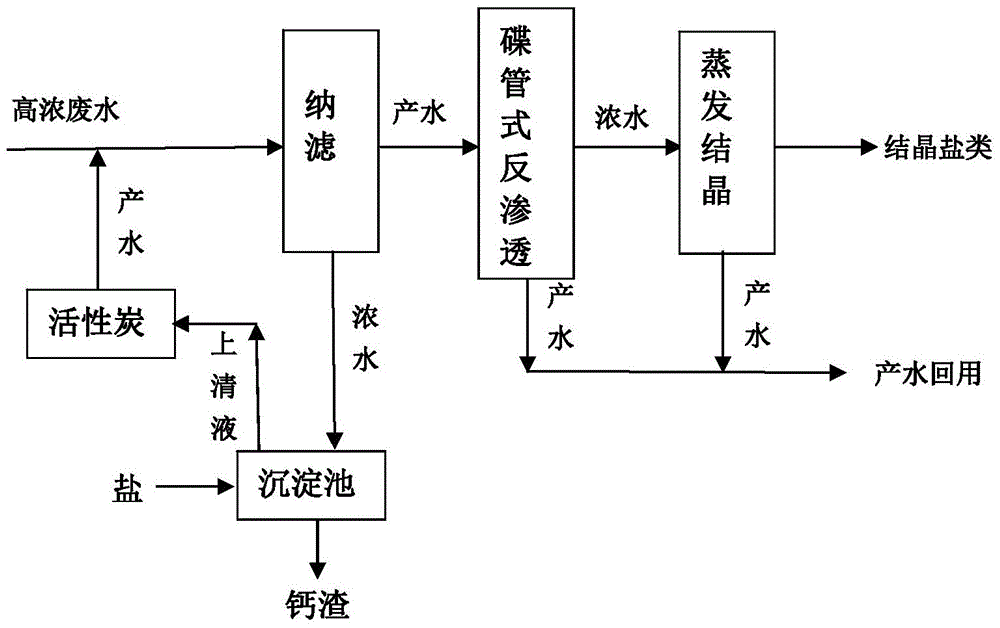High concentration wastewater zero-emission method
A concentrated wastewater, zero-discharge technology, applied in energy wastewater treatment, chemical instruments and methods, water/sewage multi-stage treatment, etc., can solve the problems of complex treatment process and unstable treatment effect, reduce membrane pollution, prolong cleaning Cycle and service life, effectiveness in solving intractable problems
- Summary
- Abstract
- Description
- Claims
- Application Information
AI Technical Summary
Problems solved by technology
Method used
Image
Examples
Embodiment 1
[0062] For a schematic diagram of the process, see figure 1 . The water quality characteristics of the high-concentration wastewater in this embodiment are: wastewater pH7, conductivity 10000 μs / cm, COD cr 100mg / L, Na + 2000mg / L, Cl - 2500mg / L, total hardness (CaCO 3 )1500mg / L, SS100mg / L, dissolved silicon 50mg / L, NH 4 -N50mg / L.
[0063] The steps of processing high-concentration wastewater by the zero discharge method of high-concentration wastewater of the present invention are as follows:
[0064] (1) Nanofiltration: The high-concentration wastewater enters the nanofiltration unit for nanofiltration treatment to remove multivalent ions such as hardness and some organic substances in the high-concentration wastewater. After separation and concentration by the nanofiltration unit, nanofiltration product water and nanofiltration concentrated water are obtained. The nanofiltration product water enters step (2) for treatment, and sodium carbonate is added to the nanofiltra...
Embodiment 2
[0080] For a schematic diagram of the process, see figure 1 . The water quality characteristics of the high-concentration wastewater in this embodiment are: wastewater pH 7.5, conductivity 15000 μs / cm, COD cr 300mg / L, Na + 3000mg / L, Cl - 3500mg / L, total hardness (CaCO 3 )2200mg / L, SS300mg / L, dissolved silicon 80mg / L, NH 4 -N200mg / L.
[0081]The operation steps of embodiment 2 are the same as embodiment 1. Wherein, the difference from Example 1 is that sodium sulfate is added to the nanofiltration concentrated water to precipitate calcium ions, and the dosage of sodium sulfate is Ca 2+ : The molar ratio of sodium sulfate is 1:1; the supernatant of the remaining nanofiltration concentrated water is adsorbed by granular activated carbon, and the dosage of granular activated carbon is granular activated carbon:COD The mass ratio is 10:1;
[0082] In the above steps, the nanofiltration membrane module of the nanofiltration unit in step (1) adopts a sulfonated polyethersulfon...
Embodiment 3
[0095] For a schematic diagram of the process, see figure 1 . The water quality characteristics of the high-concentration wastewater in this embodiment are: wastewater pH8, conductivity 20000 μs / cm, COD cr 500mg / L, Na + 4000mg / L, Cl - 5000mg / L, total hardness (CaCO 3 )3000mg / L, SS500mg / L, dissolved silicon 100mg / L, NH 4 -N500mg / L.
[0096] The operation steps of embodiment 3 are the same as embodiment 1. Wherein, the difference from Example 1 is that the nanofiltration concentrated water is added with a mixture of sodium carbonate and sodium sulfate for precipitation of calcium ions, and the dosage of the mixture of sodium carbonate and sodium sulfate is Ca 2+ The molar ratio of (sodium carbonate+sodium sulfate) is 1:1; the supernatant of nanofiltration concentrated water adopts powdered activated carbon for activated carbon adsorption, and the dosage of powdered activated carbon is powdered activated carbon: the mass ratio of COD is 8:1;
[0097] In the above-mentioned...
PUM
| Property | Measurement | Unit |
|---|---|---|
| hardness | aaaaa | aaaaa |
| hardness | aaaaa | aaaaa |
| hardness | aaaaa | aaaaa |
Abstract
Description
Claims
Application Information
 Login to View More
Login to View More - R&D
- Intellectual Property
- Life Sciences
- Materials
- Tech Scout
- Unparalleled Data Quality
- Higher Quality Content
- 60% Fewer Hallucinations
Browse by: Latest US Patents, China's latest patents, Technical Efficacy Thesaurus, Application Domain, Technology Topic, Popular Technical Reports.
© 2025 PatSnap. All rights reserved.Legal|Privacy policy|Modern Slavery Act Transparency Statement|Sitemap|About US| Contact US: help@patsnap.com

